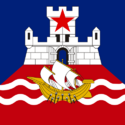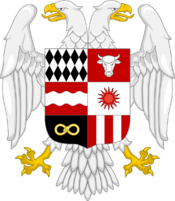East Arciluco
This article is incomplete because it is pending further input from participants, or it is a work-in-progress by one author. Please comment on this article's talk page to share your input, comments and questions. Note: To contribute to this article, you may need to seek help from the author(s) of this page. |
| East Arciluco Ⰰⱃⰽⰹⰾⱆⰽⱁ ⰴⰵ Ⰵⱄⱅ Arciluco de Est | ||||||
| Capital of the Amathian Equalist Republic | ||||||
| ||||||
| ||||||
| Demonym | East Arcilucans | |||||
| Governing Mayor | ||||||
| • | 1935-1940 | Anton Zereanu | ||||
| • | 1975-1979 | Cornel Arescu | ||||
| Historical era | Great Game | |||||
| • | Great War | 1927-1925 | ||||
| • | Treaty of Acmonia | 1935 | ||||
| • | Amathian Civil War | 1935-1936 | ||||
| • | Edelweiss Revolt | 1958 | ||||
| • | Protests of the Bloody November | 1979 | ||||
| • | Arciluco Accords | 1979 | ||||
| • | Amathian Revolution | 1979 | ||||
| Population | ||||||
| • | 1979 | 1,976,019 | ||||
| Today part of | Amathia | |||||
East Arciluco (Amathian: Ⰰⱃⰽⰹⰾⱆⰽⱁ ⰴⰵ Ⰵⱄⱅ, tr. Arciluco de Est), was the capital of the Amathian Equalist Republic from its establishment in 1935, situated in the eastern half of the city of Arciluco. With the Western side of the city being under Narozalic occupation, Amathian administration was limited to the east, where the major institutions of the Equalist state were located. The two sides of the city were divided for 44 years, until the withdrawal of the Narozalic military forces and administration through the Arciluco Accords of 1979. The division of the city played an important role in the history of Amathia as a whole, becoming a symbol of resistance against both the regime and the foreign occupation. The administrations of the two sides of the city remained separated until the end of the Amathian Revolution, only being reunified and integrated in February 1980 after the establishment of the Amathian Democratic Republic.
Overview
The Narozalic military forces invading the Kingdom of Amathia in 1935 occupied half of the former Amathian capital in according with the unofficial arrangements between the various members of the Grand Alliance, while control of the eastern part of the city was taken by the Revolutionary Equalist Front with Narozalic support. The victory of the Equalists and their Alliance for the Creation of the Republic in the Amathian Civil War led to the established of an independent Amathian state, but Narozalica refused to end its occupation of West Arciluco, forcing the Equalists to remain with only half of the city as their capital.
The very existence of East Arciluco was a source of tension in the newly created state, as many opposed the idea of the Amathian capital being placed so close to an area under foreign military occupation, but the new regime refused to abandon Arciluco as its capital. The Amathian E.R. initially refused to recognize the continued occupation and was only forced to relent after Narozalic threats, but a sort of passive resistance continued - with the name of "East Arciluco" only being used in the state's interactions with the occupying forces and the western side of the city - with all official national documents continuing to refer to the capital as a single entity. Efforts of the new regime to convince the international community to condemn this continued occupation were mixed, but Equalist resistance to the situation waned by 1944 as strategic interests in a continued alliance with Narozalica prevailed.
The issue of the division of the city continued to be a source of major tension among the population however, being perceived as a great injustice, especially following the withdrawal of military occupation forces from the neighboring Gaullica, Amathia's ally during the Great War. Public outcry, combined with rumors of the behavior of the Narozalic military forces stationed there led to violent protests in both sides of the city, and the violent repression of protests in the Eastern side led to the Edelweiss Revolt, a popular uprising against the Equalist regime that required the military intervention of Narozalica to successfully suppress. This violent expression of popular discontent is considered by many to have been the catalyst in the takeover by Equalist hardliners in 1959, who implement increasingly totalitarian policies in their attempts to strengthen their control.
The city suffered greatly during the Great Systematization of 1965, where large parts of the historic city center were demolished in order for the city to be rebuilt in accordance to the Equalist ideals, an attempt by the regime to strengthen its own image and prestige, leading to the creation the Palace of the People among others. Worsening economic conditions and limited foreign support weakened the foundations of the Equalist state, leading to East Arciluco being mocked as "the corpse of the Equalist state", especially when compared to the importance of the Western side of the city and its military forces. The beginning of the Second Narozalic Civil War shattered the final foreign support that the regime still had, and despite the insistence of the Equalists, a hastily negotiated deal in the form of the Arciluco Accords led to the withdrawal of the occupation forces and West Arciluco being returned to Amathian control. Spontaneous protests during the Narozalic withdrawal, and rumored clashes with the Narozalic troops marked the beginning of the Bloody November, considered by most historians to be the preamble of the Amathian Revolution.


